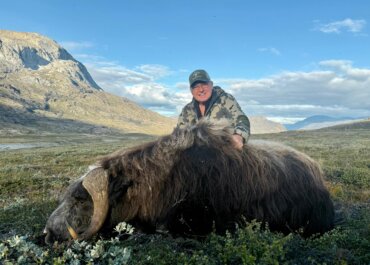When I think of Rio turkeys, I think Texas!!! Rios are concentrated in the western desert regions of Texas, Oklahoma, Kansas and other western states. But, to me, Rios and Texas just go together. As far as behavior, Rios are similar to Eastern turkeys but have tan colored tips on their tail feathers which separate them from the other subspecies of turkey. This hunt would be the second time that I have traveled to Texas for Rios and my first trip was a great hunt. The Rio populations throughout Texas are extremely healthy, so going to a good ranch with a great outfitter makes for an awesome trip.
The ranch we were hunting was in the northwest part of Texas about an hour outside of Amarillo. The ranch was a mix of thick scrub brush and deep ravines with a couple of agricultural fields and grazing pastures mixed in. It was truly a gorgeous ranch boosting high populations of Rios, Aoudad, Mule Deer and Whitetails. The outfitter, Gary, is one of WTA’s best, operating in both Texas and New Mexico. He has some great Antelope and Elk on his ranches in New Mexico; I can’t wait to get there for a hunt.
In this northwestern part of Texas, most of the trees are relatively short, with the higher trees located on the banks of the ravines or down in the bottoms of the ravines where the water is found on the ranches. Knowing where a good number of turkeys had been roosting, the plan for the first morning was simple. We were going to get between the roost and the nearby wheat field. We had roosted the birds the night before and they were in one of the tall tree areas at the bottom of a big ravine. Based on past experience, Gary said they sometimes fly off the roost to the bottom of the ravine or fly over and land on the upper rim of the canyon, which was only a quick walk over to eat in the field.
We found the perfect pinch point on the upper rim of the canyon where it first met an old pasture that led into the wheat field. As we walked to the blind, we could hear the gobblers sounding off in the canyon with their gobbles echoing throughout the canyon and up onto the rim. We were about 125 yards away, in the blind, as they sounded off from the roost. We couldn’t hear them fly down but we could tell the change in the gobble that let us know they were on the ground. It sounded like they were heading our way. After about 5 minutes of continuous gobbling, the morning turned quiet. Ten minutes after that, we caught movement out the backside of our blind and saw 3 long beards standing 15 yards away. They had stopped gobbling on their climb up the canyon wall and now were close. By the time we were able to adjust and get the camera and myself pointing out the back of the blind, the first 3 gobblers were gone. But, then a 4th gobbler appeared in the same opening as the previous 3. He didn’t give much time as he hurried through. My Kent’s did their job and with only 30 minutes into the Texas hunt, I had my Rio.
I am often asked why I’m successful and often times, quickly successful, in the field. There is an easy answer and it is that my hunts are arranged by WTA. At WTA, we work with only the best outfitters in the best areas to increase the success for our clients. If you’re looking to book a hunting or fishing adventure, make sure to give WTA a call. Our consultants have, combined, over 250 years of experience. Let WTA go to work for you!!










